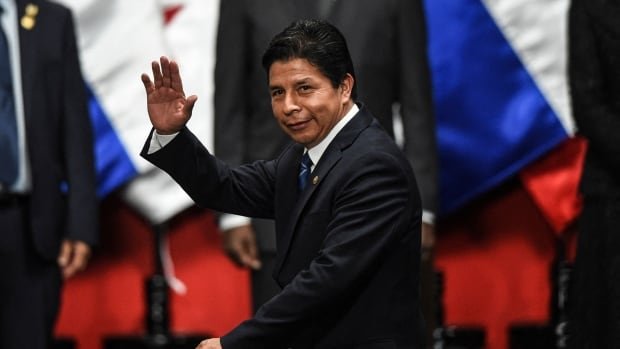The president of Peru, Pedro Castillo, was ousted by Congress and arrested on a charge of rebellion Wednesday after he sought to dissolve the legislative body and take unilateral control of the government, triggering a grave constitutional crisis.
Within hours, Vice-President Dina Boluarte was sworn in as president, becoming the first female leader in the history of the republic after hours of wrangling between the legislature and Castillo, who had tried to prevent an impeachment vote.
After lawmakers voted overwhelmingly to remove Castillo from office for reasons of “permanent moral incapacity,” he was driven from the presidential palace and through Lima’s historic downtown.
He entered a police station and hours later, federal prosecutors announced that Castillo had been arrested on the rebellion charge for allegedly violating constitutional order.
Witnesses described small-scale clashes between police and some protesters who had gathered near the station.
“We condemn the violation of constitutional order,” federal prosecutors said in a statement.
“Peru’s political constitution enshrines the separation of powers and establishes that Peru is a democratic and sovereign Republic … No authority can put itself above the Constitution and must comply with constitutional mandates.”
Shortly before the impeachment vote, Castillo announced that he was installing a new emergency government and would rule by decree. He ordered a nightly curfew starting Wednesday night. The head of Peru’s army then resigned, along with four ministers, including those over foreign affairs and the economy.
New president urges calm
Boluarte, a 60-year-old lawyer, called for a political truce and the installation of a national unity government. She said her first order of business would be to address government corruption, ostensibly what felled Castillo.
“There has been an attempted coup … that has not found an echo in the institutions, nor in the street,” Boluarte said.
“What I ask for is a space, a time to rescue the country.”
Boluarte was elected as vice president on the presidential ticket that brought Castillo to power July 28, 2021. During Castillo’s brief administration, she was minister of development and social inclusion.
‘Coup’ attempt
The national ombudsman’s office, Constitutional Tribunal and Supreme Court all called Castillo’s move to dissolve the Congress a “coup.” Ahead of the congressional vote, the ombudsman’s office said Castillo should turn himself in to judicial authorities.
Peru’s Joint Chiefs and National Police rejected the constitutionality of Castillo’s dissolution of the Congress in a statement.
At least one expert disagreed with the “coup” description.
Peru’s Congress has the ability to remove the president and the president has the ability to dissolve the Congress, so “technically, it is not a coup,” said Eduardo Gamarra, a political science and international relations professor at Florida International University.
“The confusion is in the 15,000 interpretations that exist about who prevails, the Congress or the president,” he said. The one who wins will be the one with more power, he said.
Multiple investigations
Castillo has denied allegations of corruption against him, saying they’re based on “hearsay statements by people who, seeking to lighten their own punishments for supposed crimes by abusing my confidence, are trying to involve me without evidence.”
Federal prosecutors are investigating six cases against Castillo, most of them for alleged corruption, under the theory that he has used his power to profit from public works.
The first president to come from a poor farming community in the nation’s history, Castillo arrived in the presidential palace last year without any political experience. He changed his cabinet five times during his year and a half in office, running through 60 different cabinet officials, leaving various government agencies paralyzed.
Although Castillo is the first president to be investigated while still in office, the probes are no surprise in a country where nearly every former president in the last 40 years have been charged with corruption linked to multinational corporations, such as the Brazilian construction firm Odebrecht.
Since 2016, Peru has been entrenched in political crises, with congresses and presidents trying to eliminate each other in turn. President Martin Vizcarra (2018-20) dissolved Congress in 2019 and ordered new elections.
That new legislature removed Vizcarra the next year. Then came President Manuel Merino, who lasted less than a week before a crackdown killed two protesters and injured 200 more. His successor, Francisco Sagasti, lasted nine months before Castillo took over.




